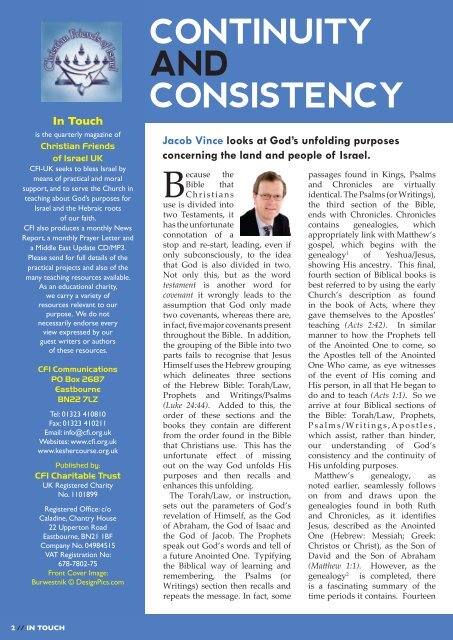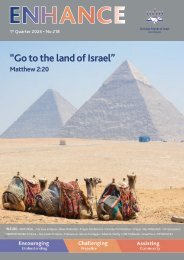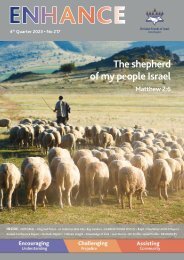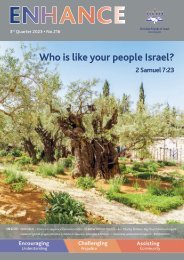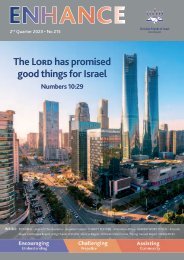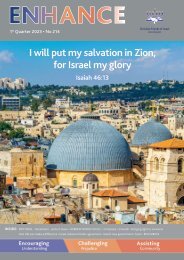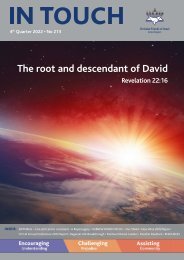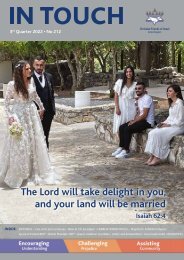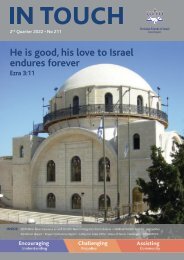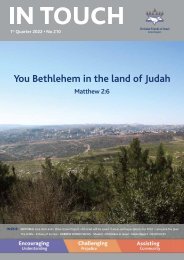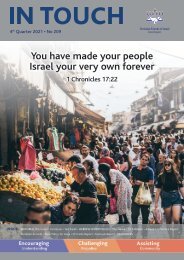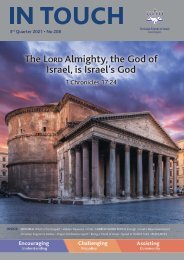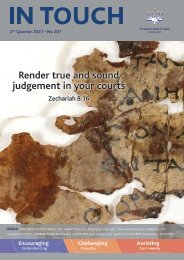In Touch Quarter 2 - 2014
You also want an ePaper? Increase the reach of your titles
YUMPU automatically turns print PDFs into web optimized ePapers that Google loves.
CONTINUITY<br />
AND<br />
CONSISTENCY<br />
<strong>In</strong> <strong>Touch</strong><br />
is the quarterly magazine of<br />
Christian Friends<br />
of Israel UK<br />
CFI-UK seeks to bless Israel by<br />
means of practical and moral<br />
support, and to serve the Church in<br />
teaching about God’s purposes for<br />
Israel and the Hebraic roots<br />
of our faith.<br />
CFI also produces a monthly News<br />
Report, a monthly Prayer Letter and<br />
a Middle East Update CD/MP3.<br />
Please send for full details of the<br />
practical projects and also of the<br />
many teaching resources available.<br />
As an educational charity,<br />
we carry a variety of<br />
resources relevant to our<br />
purpose. We do not<br />
necessarily endorse every<br />
view expressed by our<br />
guest writers or authors<br />
of these resources.<br />
CFI Communications<br />
PO Box 2687<br />
Eastbourne<br />
BN22 7LZ<br />
Tel: 01323 410810<br />
Fax: 01323 410211<br />
Email: info@cfi.org.uk<br />
Websites: www.cfi.org.uk<br />
www.keshercourse.org.uk<br />
Published by:<br />
CFI Charitable Trust<br />
UK Registered Charity<br />
No. 1101899<br />
Registered Office: c/o<br />
Caladine, Chantry House<br />
22 Upperton Road<br />
Eastbourne, BN21 1BF<br />
Company No. 04984515<br />
VAT Registration No:<br />
678-7802-75<br />
Front Cover Image:<br />
Burwestnik © DesignPics.com<br />
Jacob Vince looks at God’s unfolding purposes<br />
concerning the land and people of Israel.<br />
Because the<br />
Bible that<br />
C h r i s t i a n s<br />
use is divided into<br />
two Testaments, it<br />
has the unfortunate<br />
connotation of a<br />
stop and re-start, leading, even if<br />
only subconsciously, to the idea<br />
that God is also divided in two.<br />
Not only this, but as the word<br />
testament is another word for<br />
covenant it wrongly leads to the<br />
assumption that God only made<br />
two covenants, whereas there are,<br />
in fact, five major covenants present<br />
throughout the Bible. <strong>In</strong> addition,<br />
the grouping of the Bible into two<br />
parts fails to recognise that Jesus<br />
Himself uses the Hebrew grouping<br />
which delineates three sections<br />
of the Hebrew Bible: Torah/Law,<br />
Prophets and Writings/Psalms<br />
(Luke 24:44). Added to this, the<br />
order of these sections and the<br />
books they contain are different<br />
from the order found in the Bible<br />
that Christians use. This has the<br />
unfortunate effect of missing<br />
out on the way God unfolds His<br />
purposes and then recalls and<br />
enhances this unfolding.<br />
The Torah/Law, or instruction,<br />
sets out the parameters of God’s<br />
revelation of Himself, as the God<br />
of Abraham, the God of Isaac and<br />
the God of Jacob. The Prophets<br />
speak out God’s words and tell of<br />
a future Anointed One. Typifying<br />
the Biblical way of learning and<br />
remembering, the Psalms (or<br />
Writings) section then recalls and<br />
repeats the message. <strong>In</strong> fact, some<br />
passages found in Kings, Psalms<br />
and Chronicles are virtually<br />
identical. The Psalms (or Writings),<br />
the third section of the Bible,<br />
ends with Chronicles. Chronicles<br />
contains genealogies, which<br />
appropriately link with Matthew’s<br />
gospel, which begins with the<br />
genealogy 1 of Yeshua/Jesus,<br />
showing His ancestry. This final,<br />
fourth section of Biblical books is<br />
best referred to by using the early<br />
Church’s description as found<br />
in the book of Acts, where they<br />
gave themselves to the Apostles’<br />
teaching (Acts 2:42). <strong>In</strong> similar<br />
manner to how the Prophets tell<br />
of the Anointed One to come, so<br />
the Apostles tell of the Anointed<br />
One Who came, as eye witnesses<br />
of the event of His coming and<br />
His person, in all that He began to<br />
do and to teach (Acts 1:1). So we<br />
arrive at four Biblical sections of<br />
the Bible: Torah/Law, Prophets,<br />
P s a l m s / W r i t i n g s , A p o s t l e s ,<br />
which assist, rather than hinder,<br />
our understanding of God’s<br />
consistency and the continuity of<br />
His unfolding purposes.<br />
Matthew’s genealogy, as<br />
noted earlier, seamlessly follows<br />
on from and draws upon the<br />
genealogies found in both Ruth<br />
and Chronicles, as it identifies<br />
Jesus, described as the Anointed<br />
One (Hebrew: Messiah; Greek:<br />
Christos or Christ), as the Son of<br />
David and the Son of Abraham<br />
(Matthew 1:1). However, as the<br />
genealogy 2 is completed, there<br />
is a fascinating summary of the<br />
time periods it contains. Fourteen<br />
2 // IN TOUCH


